Few countries in the world can compare with Costa Rica. Hosting an abundance of tropical rainforests, picture-perfect beaches, and an incredible abundance of wildlife, this is a truly remarkable country and one that’s increasingly popular with adventure travelers.
Best of all, Costa Rica is consistently ranked as the safest place in Latin America according to the Global Peace Index. Home to six percent of the world’s biodiversity and with 28 percent of its land protected – one of the largest numbers in the world – Costa Rica’s green credentials are nothing short of remarkable.
It’s this unspoiled nature, combined with its consistently excellent surf, active volcanoes, and accessible hiking trails that are behind the country’s appeal.
And that’s even before we mention the incredibly welcoming local people. Known as Ticos, Costa Ricans are known for their cheerful approach to life, aka “pura vida” (pure life). Their hospitality and friendliness are second to none.
But where in this vast country should you go on your first trip to Costa Rica? It was hard to whittle the destinations down, but this list comes from the month I spent exploring the far reaches of the country – and discovering the very best it has to offer.
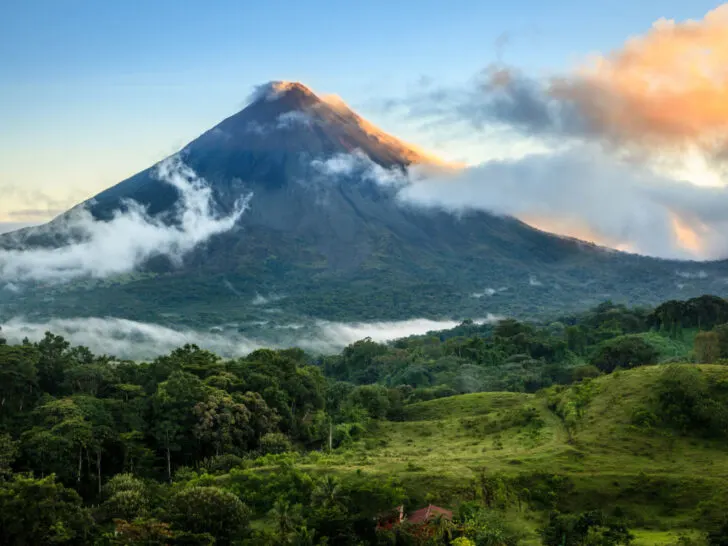
So, whether you’re looking for culture, to summit an active volcano, or to encounter some of Central America’s rarest wildlife, here’s my guide to the best places to visit in Costa Rica.
1. San José
- Why it’s great for first-timers: San José serves as the economic heart of Costa Rica and, while it doesn’t quite have the same cultural richness as other capitals such as Buenos Aires, Santiago, or Lima, it’s an introduction to the country’s history and urban life.
You’ll likely have at least a day in the Costa Rican capital before heading out into the backcountry. With just over 340,000 residents, San José is decidedly low-key, but there’s still plenty to do here.
Start with the capital’s handful of worthwhile museums, including the indigenous gold at the Museo de Oro Precolombino, before heading to the brilliant Museo del Jade, which houses the largest collection of jade in the Americas.
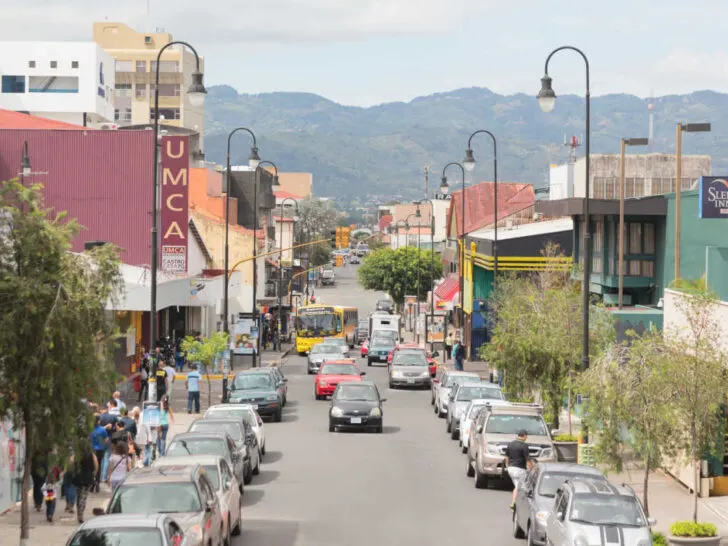
There’s nothing quite like a Central American market for a shock to the senses, so take a wander around the Central Market and try a traditional Costa Rican breakfast or lunch of gallo pinto (red and white beans with scrambled eggs) in one of the many traditional sodas (family-run restaurants) that dot the city.
Alternatively, head to Sikwa Restaurante, which is considered Costa Rica’s best, for a fancy take on indigenous recipes.
2. The Osa Peninsula
- Why it’s great for first-timers: When it comes to flora and fauna, nowhere on the planet compares with the Osa Peninsula; it’s home to a remarkable 2.5% of the world’s biodiversity. Your chance of spotting some pretty rare wildlife is exceptionally high here, making it easily one of the best places to visit in Costa Rica.
Corcovado National Park (Parque Nacional Corcovado) lies at the very heart of the Osa Peninsula and is the place to spot everything from four species of monkeys to puma, tapir, sloths, and other rare beasts.
Hiking trails crisscross its 424 square kilometers (161 sq miles), allowing you to wander through thick jungle with the calls of toucans and spider monkeys interspersed with the roar of the waves beyond.
The remotest part of the park is Sirena Ranger Station – although, as it’s only accessible by a lengthy hiking trail or one-hour boat journey, you’ll pay a pretty penny to get there.
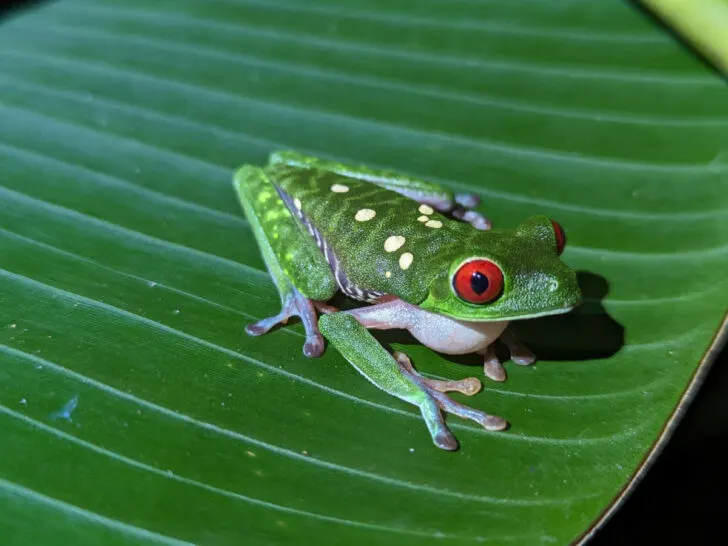
Dolphin and whale watching tours are also popular activities to do from the Osa Peninsula. I headed out on a boat to the Isla del Caño Biological Reserve (Isla del Caño Reserva Biológica), a tiny island whose protected waters are lined with coral and teeming with phosphorescent fish, dolphins, and leatherback turtles.
Hotels in the far south of the peninsula are another brilliant option for both wildlife and relaxation.
El Remanso, a luxury lodge with outstanding sea views, beautiful cabins with plunge pools, and exceptional food, was surrounded by its own slice of preserved rainforest, and I actually saw more wildlife there than in the national park itself.
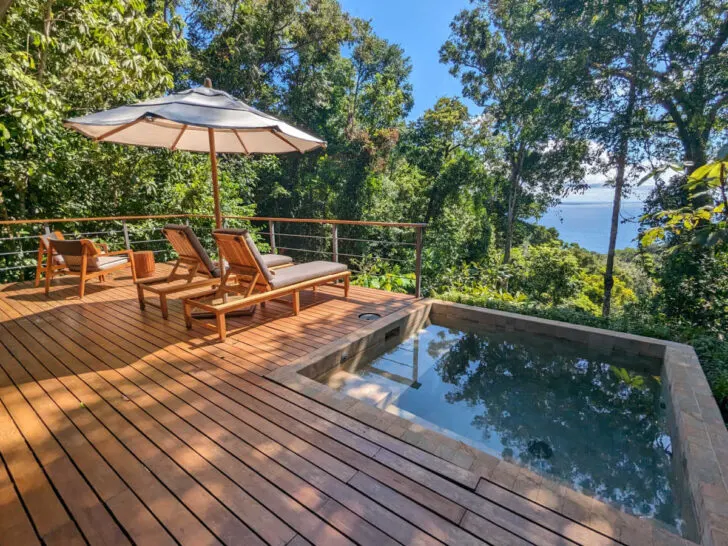
If you’re after a relaxed but wildlife-filled trip, this is one of the best vacation spots in Costa Rica.
3. Monteverde
- Why it’s great for first-timers: Monteverde’s cloud forests are just that: forests embraced by thick clouds. Rich in flora and fauna – such as the iconic resplendent quetzal – the area is both cooler (and wetter) than other parts of Costa Rica but still absolutely magical.
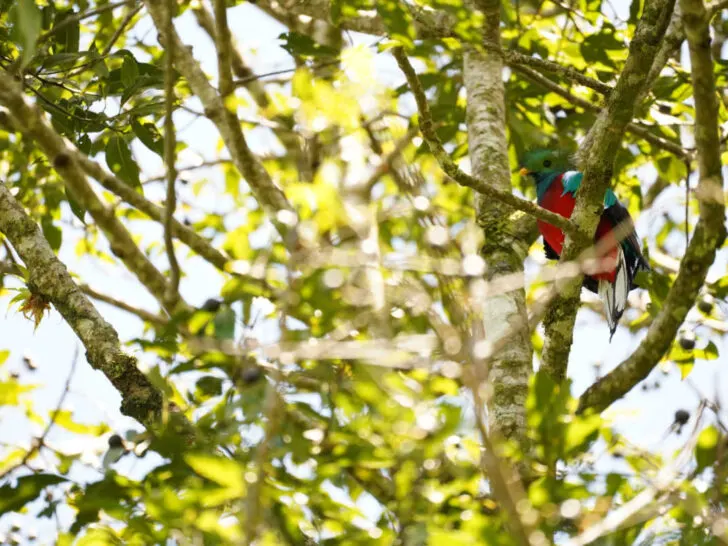
The star attraction in this region is the Monteverde Cloud Forest Reserve (Reserva Biológica Bosque Nuboso Monteverde), a tract of primary cloud forest with hiking trails, viewpoints, canopy tours, and hanging bridges.
The appeal lies, like much of Costa Rica, in the fact it’s crammed full of a stupendous amount of flora and fauna: 3,000 plant species, 100 types of mammal, and over 400 species of bird. Because it’s considered one of the best places to go in Costa Rica, the reserve does get packed with tourists.
I highly recommend instead the Santa Elena Cloud Forest Reserve (Reserva Bosque Nuboso Santa Elena) for a quieter hiking experience through the magical cloud forest.
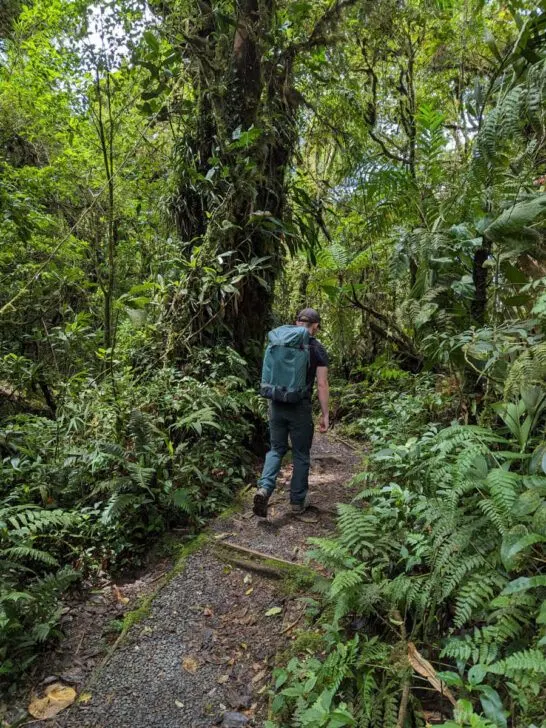
Both reserves, and the new Curi-Cancha Reserve (Reserva Curi-Cancha), are good places to spot the resplendent quetzal, an iconic – and magnificent – Costa Rican bird.
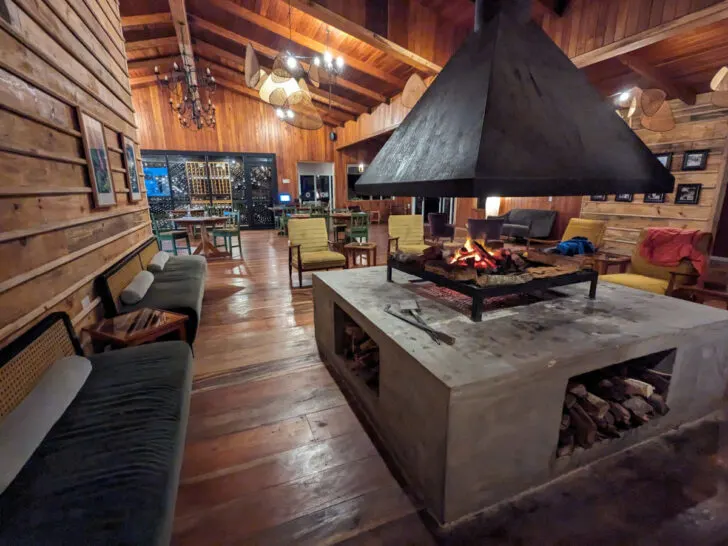
4. The Pacuare River
- Why it’s great for first-timers: Carving its way through a steep canyon fringed with primary rainforest, the Pacuare River is considered one of the best places on the planet for white water rafting and feels far deliciously from civilization.
While it’s possible to spend just a day whitewater rafting down the Pacuare River, this magical slice of jungle and tumbling water merits more of your time.
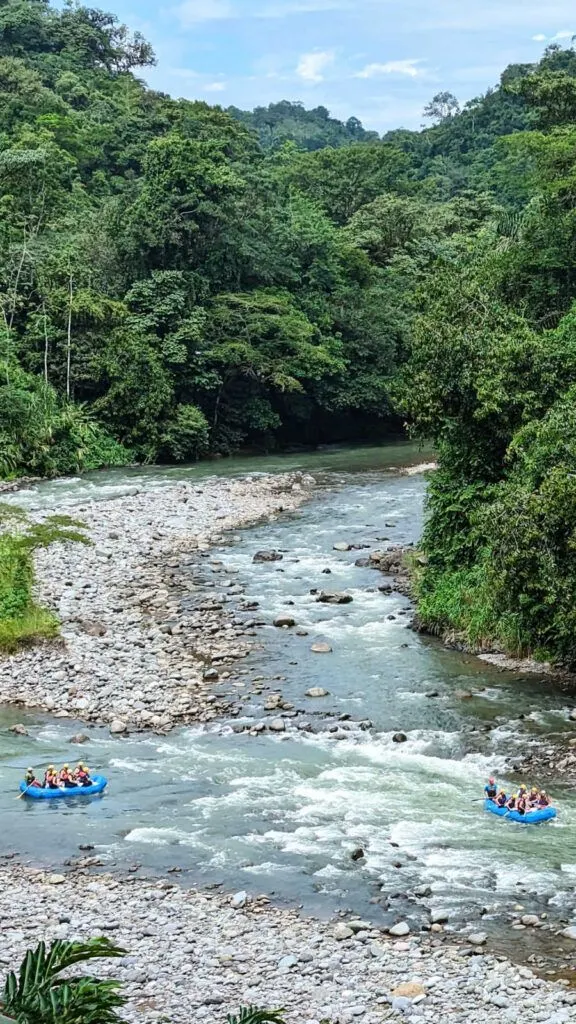
Get a 10% discount off a trip to the Pacuare River
Rios Lodge is one of the leading eco lodges along the Pacuare River and has helped drive the sustainability efforts that have protected the surrounding jungle.
The team of rafting guides are brilliant, the views from bedrooms across the river mesmorizing, and the food some of the best I ate in Costa Rica.
They’re offering a 10% discount on the price of the lodge for all Worldly Adventurer readers. Just use the code wa10 when booking.
Practically all of the lodges on the Pacuare River can only be reached and left by one means: rafting and it’s something you should definitely add to your list of Costa Rica vacation activities.
But it’s a thrill to bounce through Class I to V rapids as the raft takes you past astoundingly beautiful scenery as monkeys and kingfishers watch from above and otters plunge in the water below.
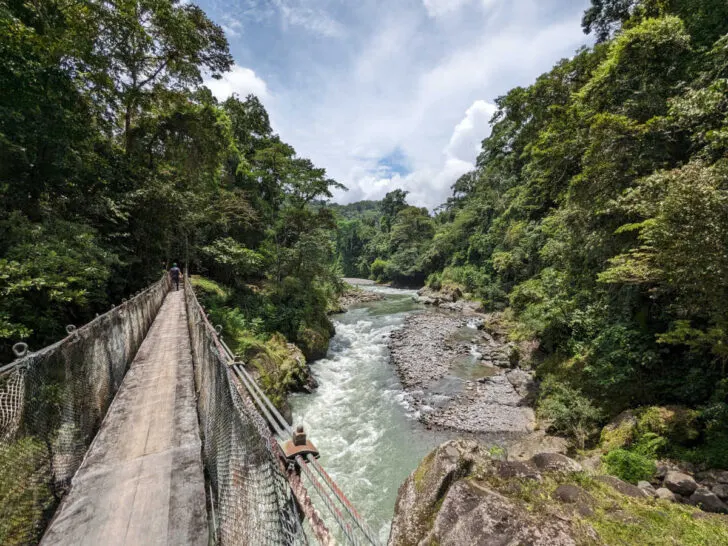
Once in a lodge here, you can enjoy everything from tubing to day hikes to waterfalls, enjoying the lodge’s incredible zipline, which passes across the river eight times with stupendous views as you speed through the treetops, or just listening to the roar of the river as you kick back in a hammock.
The Pacuare River is not just an adrenaline-pumping adventure but also an opportunity to witness a slice of absolute heaven in one of Costa Rica’s wildest corners.
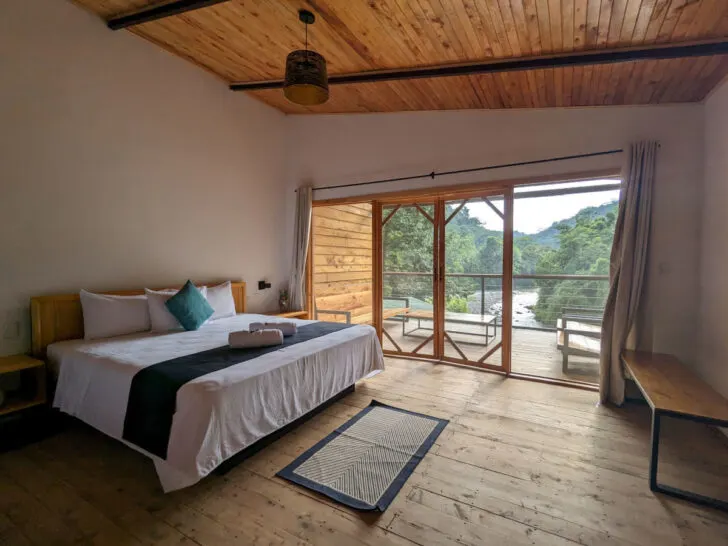
5. Uvita
- Why it’s great for first-timers: Located on Costa Rica’s South Pacific coast, Uvita is renowned for its white sand beaches, and proximity to Marino Ballena National Park, a feeding and breeding spot for migrating humpback whales.
Whether you’re a water baby or want to catch sight of some marine wildlife from a boat, the town of Uvita is the perfect place to kick back for a couple of days and tops my list of the best towns to visit in Costa Rica for first-timers.
Marino Ballena National Park (Parque Nacional Marino Ballena) covers more than 5,200 hectares (13,000 acres) of ocean and 14 kilometers (9 miles) of coastline and is where you hike to remote beaches, snorkel amongst rainbow-colored coral reefs, and motorboat through mangrove forests.
At low tide, take a wander to the “Whale’s Tail”, a sandbar in the shape of – yup, you’ve guessed it – a whale’s tail, although it’s most visible from the hotels in the hills above Uvita.
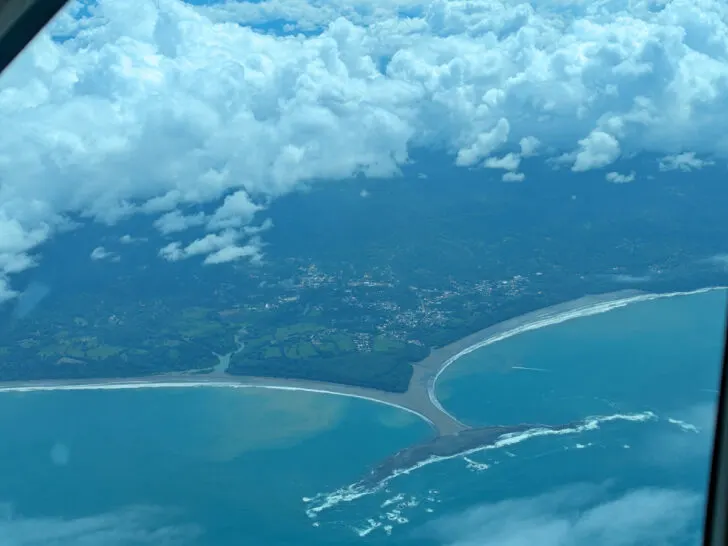
This is definitely one of the best areas to stay a few days in Costa Rica to sunbathe and swim, however, the real appeal for me was the opportunity to go whale watching.
Humpback whales flock to these waters between mid-July and the end of October; in a two-hour boat tour, we saw six groups of female whales with their offspring, plus bottlenosed dolphins, and hawksbill and olive ridley turtles.
The nearby town of Dominical is a great day trip from Uvita, where you’ll find surfing and paddleboarding, plus a hike to the stunning Nauyaca Waterfalls.
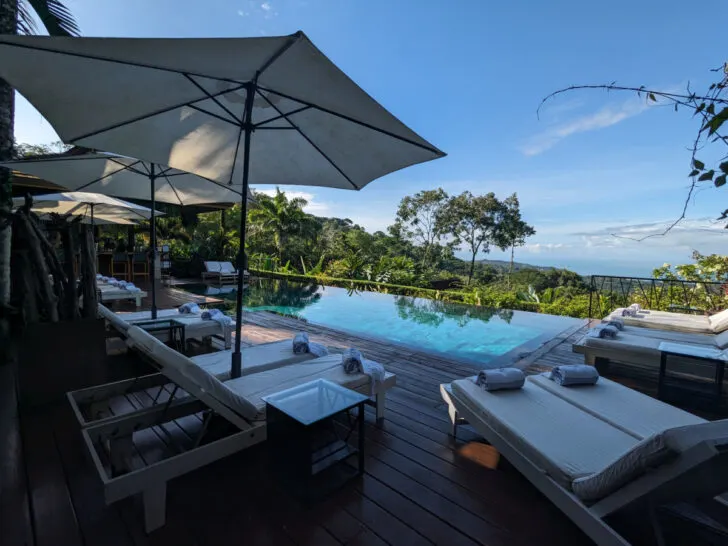
6. Tortuguero National Park
- Why it’s great for first-timers: Tortuguero National Park lies on the Caribbean coast, and, while the sweltering heat takes a while to get used to, this remote Costa Rican enclave is one of the best places to see green sea turtles. It’s definitely one of the best places to visit on Costa Rica’s Caribbean side for wildlife.
The vast Tortuguero National Park (Parque Nacional Tortuguero), which protects over 1,270 square kilometers (490 sq miles), is one of the most important nesting sites in the world for leatherback, hawksbill, and green sea turtles.
Between March and May and July and October, you can watch them pull themselves up the beach and lay some 80 eggs each into the sand. Keep an eye out for jaguars here, too; they’re easiest to spot in this area because of their love of turtle meat!
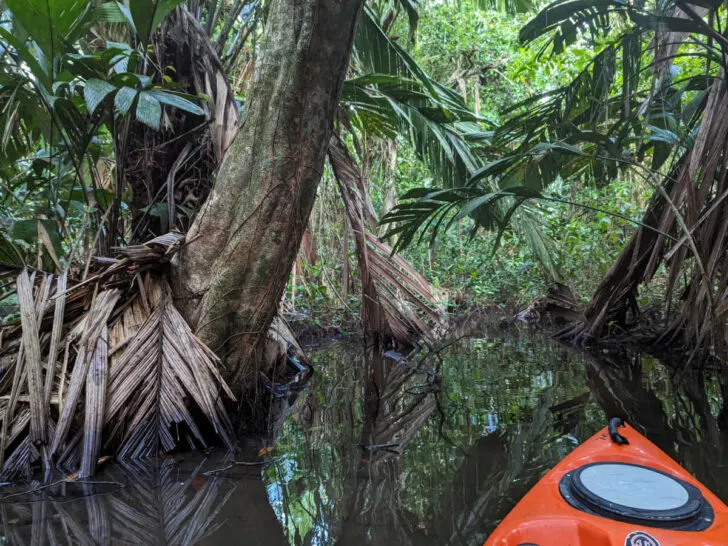
Planning a visit outside of these months? Don’t worry, between September and October, you can witness the eggs hatching.
The park’s extensive canal system is also worth exploring, with motorboat and kayak tours the best means to encounter multiple species of monkeys, sloths, and birds such as scarlet macaws and toucans.
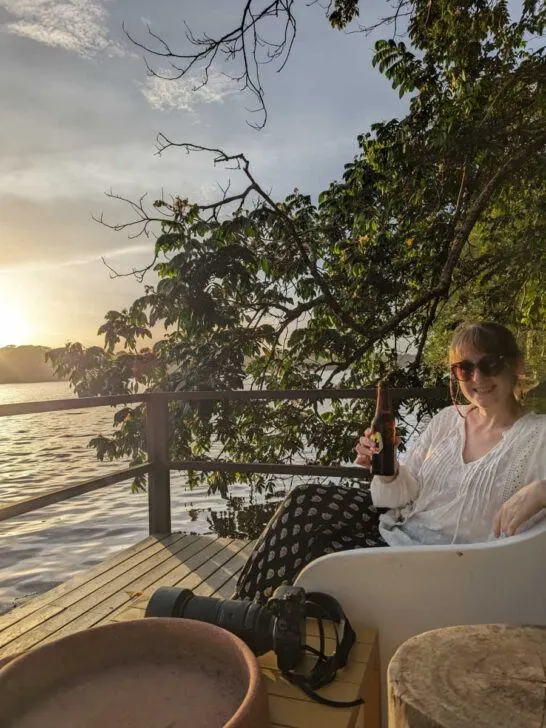
7. Laguna de Arenal
- Why it’s great for first-timers: The picturesque Arenal Lake, on whose shores lie the perfectly conical Volcán Arenal, is a pretty, low-key part of Costa Rica, where you’ll get a great introduction to the country’s volcanic background and find adventure and relaxation in spades.
The area around the regional capital, La Fortuna, is packed with activities. The most popular is hitting the hiking trails in Volcán Arenal National Park (Parque Nacional Volcán Arenal), where you’ll pass through the rugged lava flows from the volcano’s 1992 eruption.
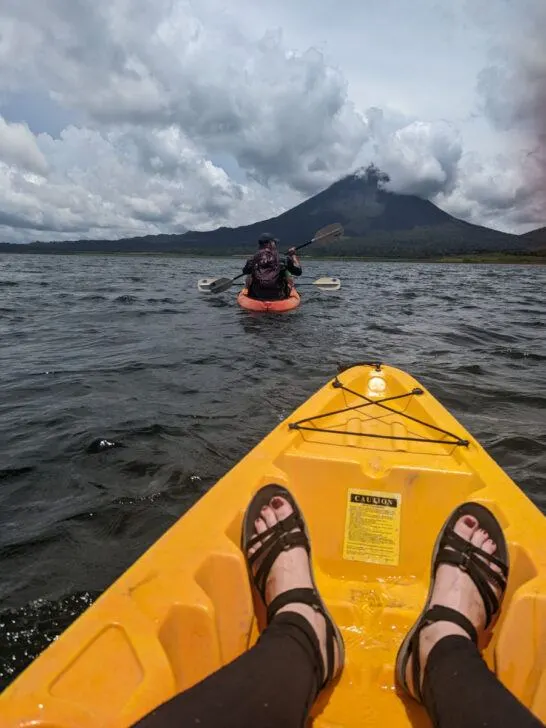
Whitewater rafting, kayaking, and ziplining are popular too. For tired limbs, the geothermal energy from the volcano (which is considered active but hasn’t erupted since 2010) has given birth to underground thermal rivers that feed mineral-rich hot springs.
You’ll find plenty in the surrounding area – many with direct views of the volcano looming in the distance.
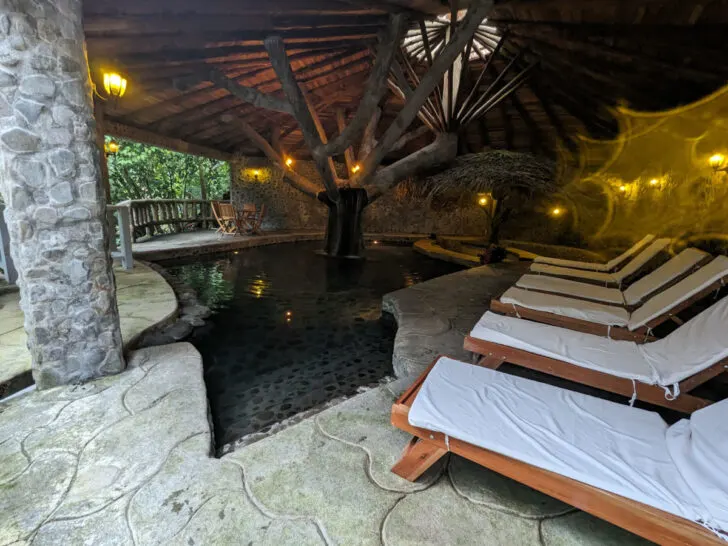
8. Nosara
- Why it’s great for first-timers: Nosara, situated on the Guanacaste coast, is a laid-back surf town known for its picture-perfect beaches, consistent surf, and yoga retreats. Unlike other popular surfing spots on the Pacific coast, it’s not rammed with tourists, either.
This sleepy, secluded town offers the perfect blend of active water sports and relaxation, without the same mass tourism of better-known towns such as Tamarindo further north. I found it ones of the most beautiful parts of Costa Rica that I visited on my one-month trip.
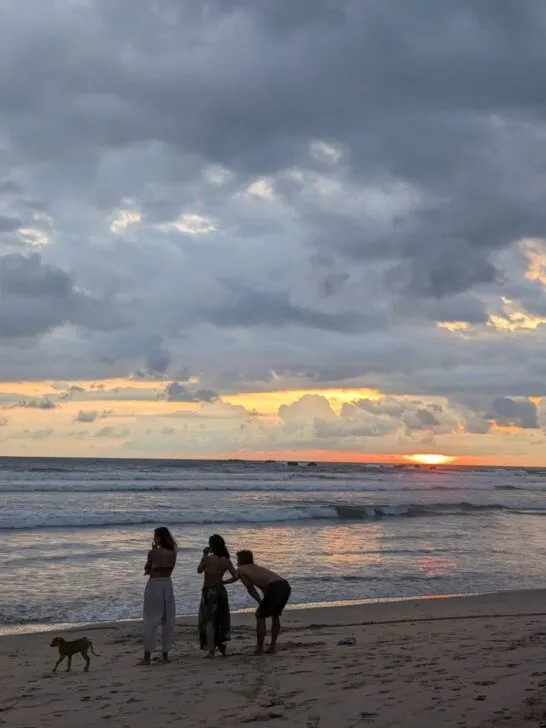
Start with a surfing class on Playa Guiones and release tired limbs with a yoga class at one of the many wellness centers in the town.
If you’re not overwhelmed by the sticky heat, go for a wander through the trails of the Nosara Biological Reserve (Reserva Biológico Nosara) on the north edge of town, where you can spot howler monkeys and even ospreys and peregrine falcons in its mangrove swamps.

Further north, the Ostional Wildlife Refuge (Refugio Nacional de Vida Silvestre Ostional) sees the mass nesting of olive ridley turtles between July and December – although they only clamber onto the shore to lay eggs during the week before the full moon.
9. Manuel Antonio National Park
- Why it’s great for first-timers: Situated on Costa Rica’s Pacific Coast, Manuel Antonio National Park is one of the country’s top destinations, thanks to its spectacular beaches and ample access to wildlife.
Protecting both picture-postcard beaches, mangroves, and rainforest, Manuel Antonio (Parque Nacional Manuel Antonio) packs a lot into what is Costa Rica’s smallest national park. If you’re not a big trekker, you’ll find short hiking trails here that are still a brilliant place to spot ample wildlife.
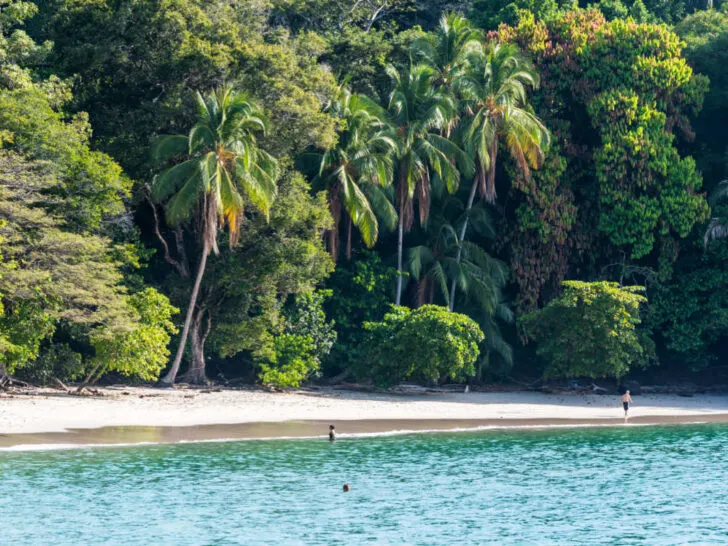
Three species of monkey – white-faced capuchin, howler, and the squirrel monkey (which is hard to see in Costa Rica) – call this protected area home, while everything from two- and three-toed sloths to agoutis, pelicans, and kingfishers are abundant here.
Visit early to avoid the crowds and ensure you’re one of the 1,200 people allowed into the park each day.
Once you’ve explored the rainforest, the park’s beautiful beaches are a good place to relax or jump in the water; beware, not all are suitable for swimming. Playa Manuel Antonio is the safest.
10. Volcán Poás
- Why it’s great for first-timers: One of Costa Rica’s most accessible – and active – volcanoes, Volcán Poás is an easy day trip from San José and a unique opportunity to view one of the largest volcanic craters in the world. Undoubtedly, it’s one of the coolest places in Costa Rica.
Almost continually active, Volcán Poás offers a stark landscape of ash and lava from previous eruptions. The most striking features are its three craters, two of which are filled with pretty turquoise water – although, be warned, it’s acidic and the fumes are toxic sulfurous gases.
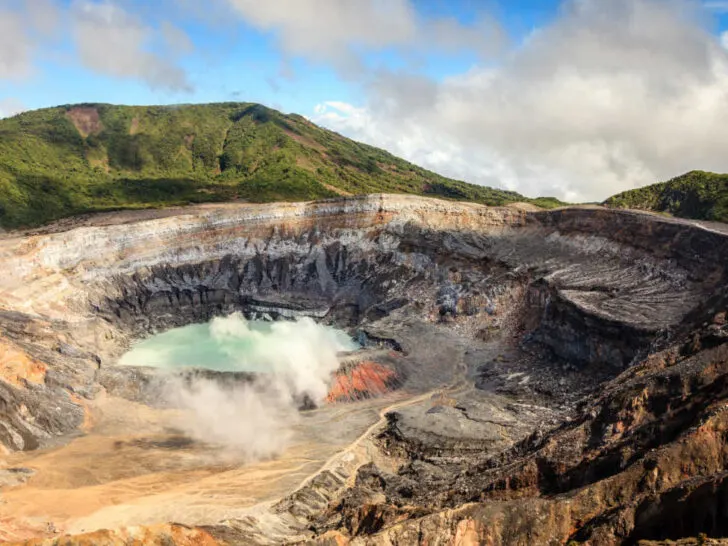
Hike to the edge of the active crater, which is bubbling and smoking, before taking on another of the short trails that wind through the cloud forest, both of which rank among the best experiences in Costa Rica.
Keep your eyes peeled for the resplendent quetzal, in all its feathery glory, and the flitting, endemic Poás volcano hummingbird.
11. Puerto Viejo de Talamanca
- Why it’s great for first-timers: Puerto Viejo de Talamanca, a beach town on the Caribbean coast, has become a popular hangout for backpackers and surfers, thanks to its dynamic nightlife, pretty, palm-fringed beaches, and some of the best waves in the country. It also has access to an indigenous reserve, where you can learn about the Bribrí culture.
Surfing is one of Puerto Viejo de Talamanca’s biggest draws, thanks to La Salsa Brava, a beginner-friendly wave that’s at its best between December and March. More challenging swells are within reach for expert surfers.
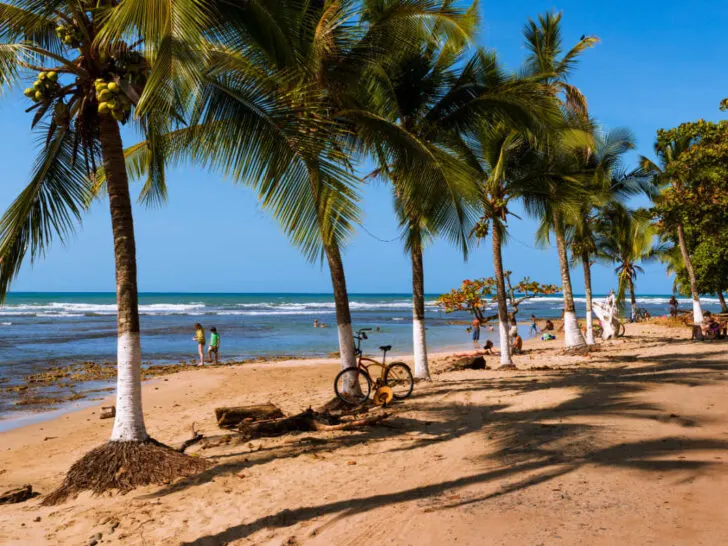
Nearby, Playa Chiquita boasts a white sand beach and is the place to kick back and relax. The clear Caribbean waters surrounding this beach are also home to colorful coral reefs and diverse marine life, making them an appealing place for a spot of snorkeling or diving.
At Punta Uva, you can also enjoy calm waters perfect for swimming. If you want a place to relax, Puerto Viejo de Talamanca is probably the best place in Costa Rica for a chilled vacation.
The town’s culinary scene is also unique, having been influenced by the Afro-Caribbean flavors of the local culture. Savor local delicacies like rice and beans, jerk chicken, and fresh seafood at the numerous beachfront restaurants, and don’t miss the chocolate, made from locally-grown cacao.
If you’re looking for culture, the nearby KéköLdi Indigenous Reserve (Reserva Indígena KéköLdi), which protects the lands of the Bribrí indigenous people, can also be visited with a local guide. As part of a tour, you’ll learn about their customs, explore the rainforest, and have a chance to buy local crafts.
12. Rincón de la Vieja National Park
- Why it’s great for first-timers: With some of the best hiking in the country, Rincón de Vieja National Park in the northwest is a protected area with brilliant infrastructure, steaming hot springs, a smoking volcano, and plenty of wildlife.
Rincón de Vieja, the park’s namesake volcano, is one of the country’s most active, and the steep, 8-kilometer (5-mile) hike up to its summit is the park’s star attraction.
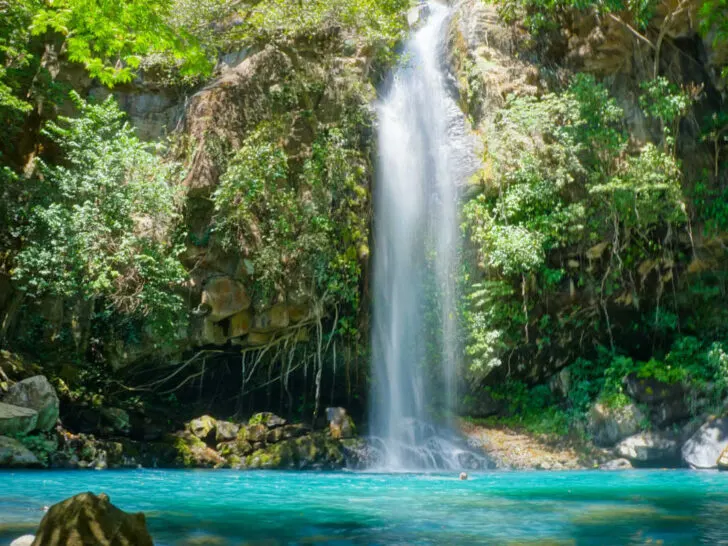
From the top, you can observe the stunning turquoise waters of the volcano’s crater lake, Lago los Jilgueros, as well as panoramas of Lago de Nicaragua across the border on a clear day.
Those preferring to go on two wheels will discover the endless mountain biking possibilities here, too.
Hot springs and the beautiful La Cangreja Waterfalls can also be visited, while nearby lodges lead horseback riding tours into some of the park’s lesser-visited areas.
13. Santa Teresa
- Why it’s great for first-timers: Bohemian Santa Teresa might be past the days of being an overlooked little town, but it’s worth all the hype. Join the backpackers and glitzy celebrities who come to the south of the Nicoya Peninsula to surf, swim, and party.
Santa Teresa is renowned for its consistent waves, with its long sweeping beaches an ideal place for beginners to learn how to surf. Many schools offer lessons for all skill levels, with Playa Carmen the best break for newbies.
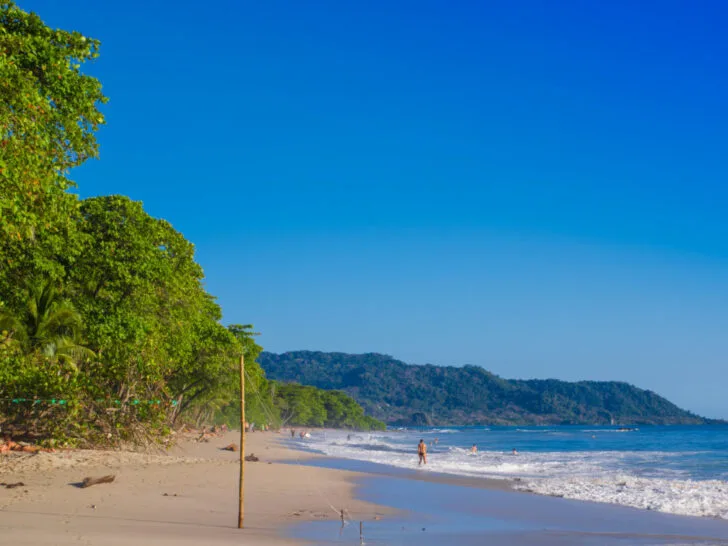
You can also join yoga classes on the beach or at one of the town’s many wellness retreats, with Santa Teresa’s serene surroundings creating the perfect environment for rejuvenation. Sunbathing, swimming, or just watching as the sun slips into the ocean at dusk are other chilled pastimes. Santa Teresa is another of the best relaxed vacation spots in Costa Rica.
Alternatively, head to Cabo Blanco Nature Reserve (Reserva Natural Absoluta Cabo Blanco), the country’s oldest protected area. This tropical forest is interspersed with trails, picturesque beaches, and plenty of wildlife, including monkeys, deer, and collared peccary.
At night, jump into the town’s acclaimed nightlife, where you’ll find international DJs and plenty of time to party.
14. Caño Negro National Wildlife Refuge
- Why it’s great for first-timers: Sitting right on the border with Nicaragua, Caño Negro National Wildlife Refuge is a pristine wetland teeming with biodiversity, including a staggering number of birds, making it the ultimate spot for seeing Costa Rica’s incredible endemic avian species.
Caño Negro National Wildlife Refuge (Caño Negro Refugio Nacional de Via Silvestre) is a paradise for bird watchers. The reserve is home to well over 400 migratory and resident bird species, including large storks, cormorants, and multiple types of heron, plus rarer species including the beautiful pink-hued roseate spoonbill.
Reptiles are also out in numbers, with caimans, iguanas, and swimming snakes possible to see, whether you want to or not!
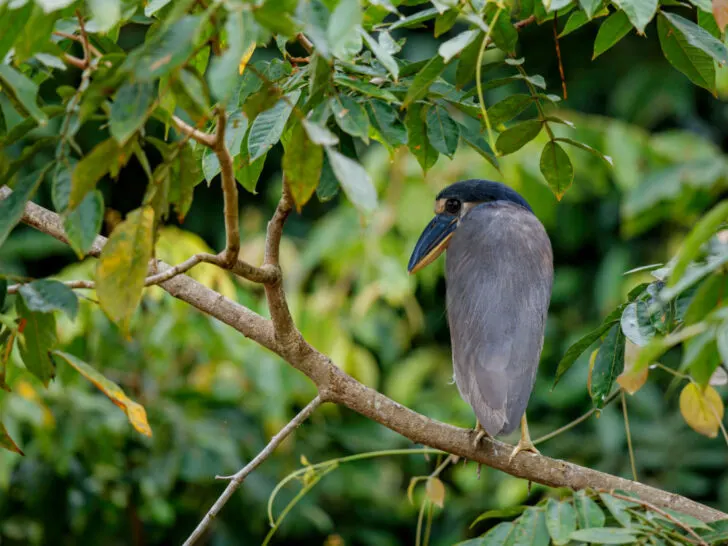
The best way to explore the refuge is with a tour, and, depending on the time of year, the experience will be vastly different.
Between December and April, you’ll be walking along the dried riverbed of the Río Frío; outside of these months, you’ll putter across the reserve by motorboat as the river floods its banks to become a 1,980-acre (3 sq-mile) lagoon.
15. Heredia
- Why it’s great for first-timers: This extension of San José’s urban sprawl promises great views of the capital from its lofty location, plus organic coffee tours and wildlife.
Most of the capital’s appeal actually lies outside of the city and basing yourself for a couple of days in the hills above is a great way to relax at the start or the end of your trip.
One of the best places to stay is Finca Santa Rosa, an organic coffee farm and family-run boutique hotel that has been pioneering sustainable and regenerative tourism in Costa Rica for over 30 years.
Their 12 hectares (30 acres) of land are cultivated according to permaculture principles and it’s well worth doing a tour of their estate followed by a coffee cupping. You’ll realize how little you ever knew about coffee!
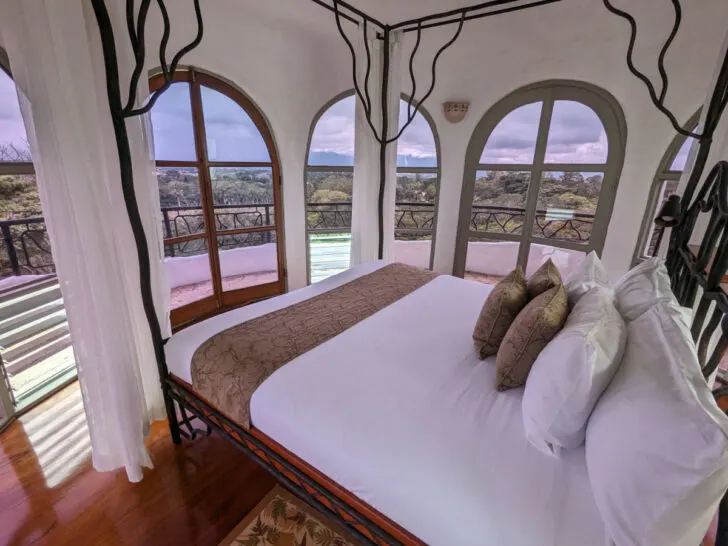
Wildlife watching is a possibility here, too. If you’re worried about not seeing some of Costa Rica’s signature wildlife, then a trip to the nearby Toucan Rescue Ranch can ensure you get up close and personal with sloths, spider monkeys, and even rare oncillas, then this is your place.
Ready to start planning your trip to Latin America? Find inspiration on the best countries to visit in South America, discover the best places to visit in South America, plan your trip with seven of my favorite South America travel itineraries and head to the other end of the region, Patagonia. You can explore the best places to visit in Patagonia and uncover how to get to Patagonia.
